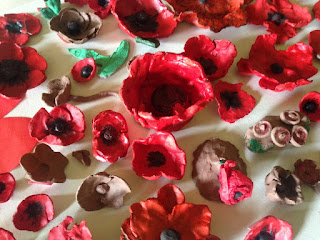Curator Kitty Ross reveals the story behind the popular 1930s 'Murder in the Museum' penny slot machine at Abbey House Museum!
 |
| 'Murder in the Museum' (1934 model made by Alice and Eveline Dennison) |
One of Abbey House Museum's star objects, the penny slot machine 'Murder in the Museum' has recently been restored to
full working order. The comically
macabre automaton is subtitled 'Who Killed the Man in the Chair?' and the
suspects in this 1930s murder mystery include a woman with a large handbag, a man lurking behind a display
cabinet and a man hiding inside the Egyptian sarcophagus.
The Dennison dioramas and automatons
The machine was made in 1934 at the height of
the Golden Age of crime fiction and was the work of two Leeds sisters, Alice
and Eveline Dennison.
The family association with macabre penny slot machines
started with their father, John Dennison (1847-1924) who was born in Leeds. He
displayed his first working his first working models, demonstrations of a drilling
machine and a hand lathe, at the 1875 Yorkshire Exhibition, which were well
received by the public. He soon began building both mechanical fortune teller
machines and working model dioramas for installation at exhibitions, fairs and
bazaars.
By 1884 John had a small
exhibition (possibly already in Blackpool). His machines had melodramatic subjects, such as the
Dying Child, Drunkard’s Delirium, Haunted Miser and of course the French
Execution (now owned by Leeds Museums), pictured above.
John Dennison first exhibited in the old Aquarium in
Blackpool in 1891 and he became a fixture in Blackpool Tower when it opened in
1894. It was a family business,
including John’s brother William and his son George from his first marriage.  |
The French Execution, designed by John Dennison in 1894 and now
|
 |
Ledden. REPRODUCTION OF THIS IMAGE IS PROHIBITED) |
The talented Dennison sisters
The three daughters from John Dennison's second marriage, Florence, Alice and Eveline, started by helping their father with his models but soon began to develop ideas of their own. John Dennison valued their contribution and seems to have fiercely discouraged them from marrying out of the family business!
Alice Dennison (1890-1966) initially worked as a governess and
then as a dress maker, and was the inspiration behind the costumes for the
models. She also turned her hand to the
machinery side of the business and was behind the decision to move from
clockwork to electricity.
Eveline Dennison (1896-1970) had been an art student who won a scholarship and she was the artistic one, intricately creating the models out of wood and clay. Their elder sister Florence seems to have been more in charge of the business of running the Blackpool enterprise.
Eveline Dennison (1896-1970) had been an art student who won a scholarship and she was the artistic one, intricately creating the models out of wood and clay. Their elder sister Florence seems to have been more in charge of the business of running the Blackpool enterprise.
 |
| Extract from Alice and Eveline Dennison's notebook |
The Mechanics of Murder
The Dennisons left Blackpool Tower in 1944 and sold the machines to the Tower Company, from where they have been dispersed around the world.Quoted in the Blackpool Gazette in 1963 the Dennison sisters stated:
“The most popular models we created were always those with a morbid flavour – “Supper with Death”, “Midnight in the Haunted Churchyard”, “Murder in the Museum”. Anyone who imagines that children prefer fairy stories are way off beam. During the 20 years we held the business we learned a lot about human nature”.
 |
|
The cast of 'Murder in the Museum' in the Still Room at Temple Newsam House. (Photograph by Danny Young of Target Productions) |
By Kitty Ross, Curator of Social History
(Unless otherwise stated, all photographs published here were taken for Leeds Museums and Galleries and are licensed under Creative Commons BY NC SA.)































